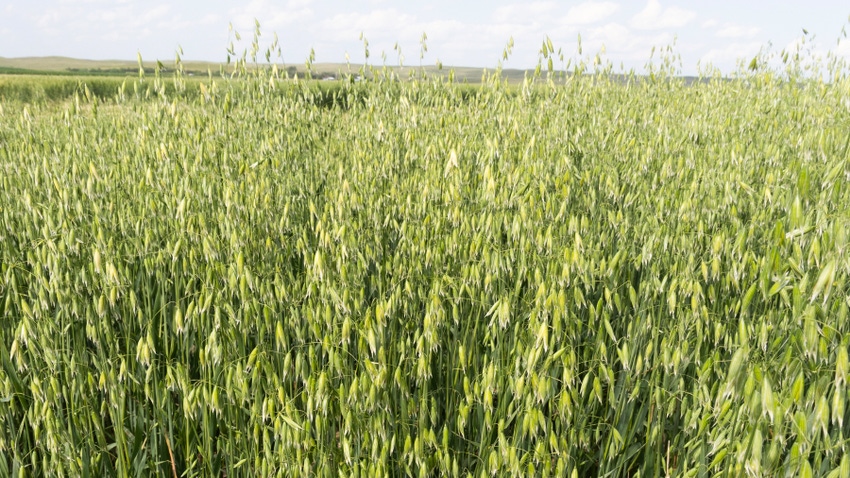February 26, 2024

This winter’s erratic weather, with wind chills from minus 30 degrees F to unseasonably warm highs in the 50s, has left many farmers pondering whether to frost-seed or not to frost-seed. In mid-February, the dilemma intensified, with some farmers already contemplating drilling spring oats or alfalfa.
“Let’s not get too hasty,” advises Shelby Gruss, Iowa State University Extension forage specialist. “The weather may seem nice and suitable for planting the seed, but we are still in February and could easily face some future hard frosts and cold temperatures.”
Spring cereals and alfalfa are cold-tolerant, but low temperatures can lead to uneven germination and significant damage due to a hard frost. “Waiting a couple of weeks can be beneficial to ensure we don’t have more winter-like temperatures heading our way,” Gruss says. “It seems spring has started, but it is only February.”
How about frost seeding?
Another opportunity many are considering is frost seeding. This practice offers some advantages compared to seeding with a drill. Frost seeding involves strategically broadcasting or overseeding legumes into a tired pasture or within a small-grain stand, such as oats, rye, barley or winter wheat.
“Frost seeding is a potentially cost-effective solution to revitalize a diminishing stand or to introduce new legumes into a forage or pasture,” Gruss says. “However, success with frost seeding hinges upon proper timing and assessing the condition of the existing stand.”
A thick thatch can pose a challenge, hindering optimal seed-to-soil contact and fostering competition for the seedlings. To mitigate this, it is recommended to closely harvest the small-grain crop as hay or over-graze it in the fall or winter to open the canopy in preparation for frost seeding.
“Ideally, visible bare spots are a good indicator of a pasture stand that frost-seeding is more likely to be successful,” Gruss notes.
Timing critical
Timing and soil conditions are critical to successful frost-seeding. Typically, the time for frost-seeding falls between mid-February and early March, coinciding with the freeze-thaw cycle. Some weeks in February exhibited glimpses of the freeze-thaw cycle occurring, indicating the opportunity for doing the frost seeding.
However, checking future weather forecasts is crucial, as many parts of Iowa are experiencing warmer temperatures. “We need to check the lows and highs for the freeze-thaw interaction,” Gruss says. “The rhythmic expansion and contraction of soil during freezing and thawing creates a honeycombing effect, helping to incorporate seed into the soil profile and ensuring good seed-to-soil contact.”
Though, attention is required to avoid soil compaction when you are doing the seeding, she says. That necessitates early-morning seeding operations while the soil remains frozen to prevent soil compaction when the soil is wet.
In some conditions, the use of farm animals such as grazing cattle can help incorporate the seed, ensuring good seed-to-soil contact through their hoof action. But doing this when the field is too wet can lead to damaging the pasture.
Keys to successful seeding
“Moreover, the fate of the seeded stand hinges significantly on spring moisture levels,” Gruss says. “Adequate moisture is vital for establishing a healthy stand.”
Thus, while the potential benefits of frost-seeding are high, it’s the timing, soil condition and moisture that play important roles in success. “Evaluation of your stand and the future weather forecast can help determine the correct timing for frost seeding in the spring.”
ISU Extension publication Interseeding and No-Till Pasture Renovation has more information, including suggested seeding rates and other guidelines.
Summing up
Frost seeding involves spreading forage seed on existing pastures during late winter or early spring while ground is still frozen. Freeze-thaw cycles then provide shallow coverage of seed, helping shield seeds from early spring rains.
Frost seeding has advantages compared to drilling seed into the soil. But timing is critical. If you frost-seed too early the seed may die. If you seed too late, there is no frost to do the work of moving the seed into the soil.
Frost seeding can be accomplished with broadcast spreaders mounted on ATVs or tractor three-point hitches. Frost seeding is a practice that minimizes equipment expense and erosion concerns over tillage practices. While it can be less reliable than seeding with a drill, frost seeding is commonly used to increase forage plant diversity and yield, and to reduce weed pressure.
Swoboda is an editor emeritus of Wallaces Farmer.
Read more about:
SeedAbout the Author(s)
You May Also Like






